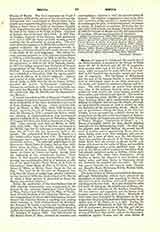

Mecca, the capital of Arabia and the sacred city of the Mohammedans, is situated in the district of Hijaz about 21° 30′ N. latitude and 40° 20′ E. longitude, some seventy miles east of the Red Sea. It lies in a sandy valley surrounded by rocky hills from two hundred to five hundred feet in height, barren and destitute of vegetation. The birthplace of Mohammed and the seat of the famous Kaaba, it was celebrated even in pre-Islamic times as the chief sanctuary of the Arabs, and visited by numerous pilgrims and devotees. The city presents an aspect more pleasing than that of the ordinary Eastern town, with comparatively wide streets and stone houses, usually of three stories, and well aired and lighted. The inhabitants, numbering about 60,000, are with few exceptions Arabians whose chief employment consists in lodging the pilgrims and serving the temple, although no inconsiderable amount of trade is carried on with the Bedouins of the surrounding desert. Mecca, the seat of government during the reign of the first five Khalifs, is now governed by a Sharif, chosen by the people from the Sayyids or the descendants of Mohammed, but under the immediate authority of the Sultan of Turkey (Hughes, “Dictionary of Islam“, q.v.). Mecca is annually visited by some 80,000 pilgrims from all over the Mohammedan world. On their way the pilgrims pass through Medina, the second sacred town of Arabia, and on approaching Mecca they undress, laying aside even their headgear, and put on aprons and a piece of cloth over the left shoulder. Then they perform the circuit of the Kaaba, kiss the Black Stone, hear the sermon on Mount Arafat, pelt Satan with stones in the valley of Mina, and conclude their pilgrimage with a great sacrificial feast. In a year or two Mecca will be reached by the Hijaz Railway already completed as far as Medina, (about eight hundred and fifty miles from Damascus). From Medina to Mecca the distance is two hundred and eighty miles, and from Mecca to Damascus about one thousand one hundred and ten miles. The railway passes through the old caravan route, Damascus, Mezarib, Maan, Medawara, Tebuk, Madain Saleh, El-Ula, Medina, and Mecca.
The early history of Mecca is shrouded in obscurity, although Mohammedan writers have preserved an abundance of legendary lore according to which the city dates back to Abraham who is said to have there worshipped the true God. It is also stated that after the death of Abraham, the inhabitants of Mecca, owing to the evil influence of the heathen Amalekites, fell into idolatry and paganism, and the Kaaba itself became surrounded with their idols. Hundreds of these idols were destroyed by Mohammed on his entrance into the city at the head of a Moslem army in the eighth year of the Hejira, or A.D. OM During the century before Mohammed we find the tribe of Quraish in undisputed possession of the city and the acknowledged guardians of the Kaaba. The leading events in Mecca at that period, such as the Abyssinian expedition against Yemen and the utter defeat of Abraha’s army at the hand of the Meccans, have been already discussed in the article Christianity in Arabia.
GABRIEL OUSSANI

